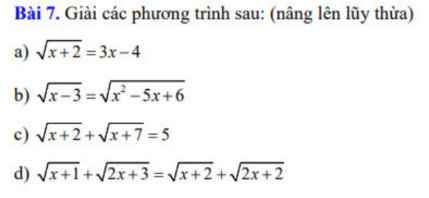trình bày đầy đủ ạ để mik còn hỉu ngu toán lâu năm

Hãy nhập câu hỏi của bạn vào đây, nếu là tài khoản VIP, bạn sẽ được ưu tiên trả lời.


c: ⇔n+2∈{1;−1;5;−5}⇔n+2∈{1;−1;5;−5}
hay n∈{−1;−3;3;−7}n∈{−1;−3;3;−7}
d: ⇔n+2∈{1;−1;2;−2;4;−4}⇔n+2∈{1;−1;2;−2;4;−4}
hay n∈{−1;−3;0;−4;2;−6}n∈{−1;−3;0;−4;2;−6}
a: ⇔n−1∈{1;−1;5;−5}⇔n−1∈{1;−1;5;−5}
hay n∈{2;0;6;−4}
b: \(\Leftrightarrow n+1\in\left\{1;-1;2;-2;4;-4\right\}\)
hay \(n\in\left\{0;-2;1;-3;3;-5\right\}\)
c: \(\Leftrightarrow n+2\in\left\{1;-1;5;-5\right\}\)
hay \(n\in\left\{-1;-3;3;-7\right\}\)
d: \(\Leftrightarrow n+2\in\left\{1;-1;2;-2;4;-4\right\}\)
hay \(n\in\left\{-1;-3;0;-4;2;-6\right\}\)
a: \(\Leftrightarrow n-1\in\left\{1;-1;5;-5\right\}\)
hay \(n\in\left\{2;0;6;-4\right\}\)

1 số có thể chia hết cho 2 và 5 thì số đó phải có chữ số tận cùng là 0
=>Điền y = 0

\(3,Đk:x\ge0\\ PT\Leftrightarrow\left(\sqrt{x}-2\right)\left(2\sqrt{x}-1\right)=0\\ \Leftrightarrow\left[{}\begin{matrix}\sqrt{x}=2\\\sqrt{x}=\dfrac{1}{2}\end{matrix}\right.\Leftrightarrow\left[{}\begin{matrix}x=4\left(tm\right)\\x=\dfrac{1}{4}\left(tm\right)\end{matrix}\right.\\ 7,ĐK:x\ge0\\ PT\Leftrightarrow\left(\sqrt{x+1}-\sqrt{x\left(x+1\right)}\right)+\left(\sqrt{x}-1\right)=0\\ \Leftrightarrow-\sqrt{x+1}\left(\sqrt{x}-1\right)+\left(\sqrt{x}-1\right)=0\\ \Leftrightarrow\left(\sqrt{x}-1\right)\left(1-\sqrt{x+1}\right)=0\\ \Leftrightarrow\left[{}\begin{matrix}x=1\left(tm\right)\\x+1=1\end{matrix}\right.\Leftrightarrow\left[{}\begin{matrix}x=1\\x=0\end{matrix}\right.\)
\(4,ĐK:1\le x\le\sqrt{5}\\ PT\Leftrightarrow5-x^2=x^2-2x+1\\ \Leftrightarrow x=-2\left(ktm\right)\Leftrightarrow x\in\varnothing\)

Lời giải:
ĐKXĐ: $x\geq 0$
$-\sqrt{x}(\sqrt{x}-1)>0$
$\Leftrightarrow \sqrt{x}(\sqrt{x}-1)<0$
\(\Leftrightarrow \left[\begin{matrix} \left\{\begin{matrix} \sqrt{x}>0\\ \sqrt{x}-1<0\end{matrix}\right.\\ \left\{\begin{matrix} \sqrt{x}<0\\ \sqrt{x}-1>0\end{matrix}\right. (\text{TH này hiển nhiên vô lý})\end{matrix}\right. \)
\(\Leftrightarrow \left\{\begin{matrix} x>0\\ 0\leq x< 1\end{matrix}\right.\Leftrightarrow 0< x< 1\)

Vậy ta có tỉ số của st1 và st2 là \(\dfrac{5}{1}\)
ta có sơ đồ:
st1: 272/(5-1)*5=340
st2:272/(5-1)*1=68
đáp số:st1 340,st2 68
tick cho mik nha.

\(\dfrac{2}{3}+\dfrac{4}{5}\times\dfrac{5}{6}=\dfrac{2}{3}+\dfrac{2}{3}=\dfrac{4}{3}\)

3 thế kỉ = 300 năm + 67 năm = 367 năm
2 thế kỉ = 200 năm + 61 năm = 261 năm
3 thế kỉ = 300 năm + 63 năm = 363 năm
vậy 3 thế kỉ 67 năm + 2 thế kỉ 61 năm - 3 thế kỉ 63 năm
= 367 + 261 - 363
=265 năm
HT
3 thế kỉ 67 năm = 367 năm
2 thế kỉ 61 năm = 261 năm
3 thế kỉ 63 năm = 363 năm
367 năm + 261 năm - 363 năm = 628 năm - 363 năm = 265 năm
/HT\

Bài 6:
b: PTHĐGĐ là:
\(x^2+4x-1=x-3\)
\(\Leftrightarrow x^2+3x-4=0\)
\(\Leftrightarrow\left[{}\begin{matrix}x=-4\\x=1\end{matrix}\right.\Leftrightarrow\left[{}\begin{matrix}y=-7\\y=-2\end{matrix}\right.\)
\(a,ĐK:x\ge\dfrac{4}{3}\\ PT\Leftrightarrow x+2=9x^2-24x+16\\ \Leftrightarrow9x^2-25x+14=0\\ \Leftrightarrow x=\dfrac{25+\sqrt{569}}{2}\)
b: \(\Leftrightarrow x^2-5x+6=x-3\)
hay x=3